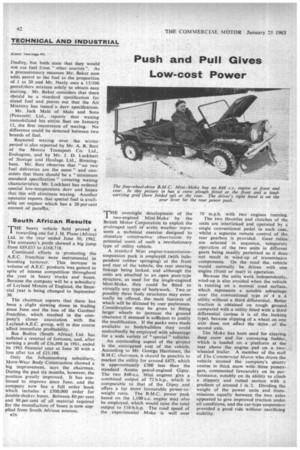Push and Pull Gives Low-cost Power
Page 44

If you've noticed an error in this article please click here to report it so we can fix it.
THE overnight development of the two-engined Mini-Moke by the British Motor Corporation to exploit the prolonged spell of arctic weather represents a technical exercise designed to stimulate constructive observation by potential users of such a revolutionary type of utility vehicle.
A standard Mini engine-transmissionsuspension pack is employed (with independent rubber springing) at the front and rear of the vehicle, the rear steering linkage being locked, and although the units are attached to an open punt-type structure, as used for the single-engined Mini-Moke, they could be fitted to virtually any type of bodywork. Two or possibly three body structures may eventually be offered, the main features of which will be dictated by user preference. Consideration may be given to fitting larger wheels to increase the ground clearance if demand is sufficient to justify the modification. If the packs were made available to bodybuilders they could undoubtedly be employed with advantage for a wide variety of "special " vehicles.
An outstanding aspect of the project is the anticipated cost of the vehicle. According to Mr. George Harriman, the B.M.C. chairman, it should be possible to market the utility for around £475, which is approximately £200 less than the standard Austin petrol-engined Gipsy. The two 848-c.c. Mini engines give a combined output of 72 b.h.p., which is comparable to that of the Gipsy and offers a far more favourable power-toweight ratio. The B.M.C. power pack based on the 1,100 c.c. engine may also be employed, which would raise the total output to 110 b.h.p, The road speed of the experimental Moke is well over 70 m.p.h. with two engines running.
The two throttles and clutches of the units are interlinked and operated by a single conventional pedal in each ease. whilst a separate remote control of the rear gearbox is provided. Gear ratios are selected in sequence, temporary operation of the two units in different gears being readily permitted as it does not result in wind-up of transmission components. On the road the vehicle would normally be driven with one engine (front or rear) in operation.
Because the units work independently, wind-up is also avoided when the vehicle is running on a normal road surface, which represents a notable advantage over the conventional type of 4 x 4 utility without a third differential. Better traction is obtained on rough ground compared with a utility fitted with a third differential (unless it is of the locking type), because slipping of a wheel on one axle does not affect the drive of the second axle.
The Moke has been used for clearing deep snow and for conveying fodder. which is loaded on a platform at the rear above the engine and on a two. wheeled trailer. A member of the staff of The Commercial Motor who drove the vehicle around the company's quarry course in thick snow with three passengers, commented favourably on its performance, notably on its ability to climb a slippery and rutted section with a gradient of around 1 in 2. Dividing the weight of the power units and transmissions equally between the two axles appeared to give improved traction under all conditions, and the car-type suspension provided a good ride without sacrificing stability.
















































































































